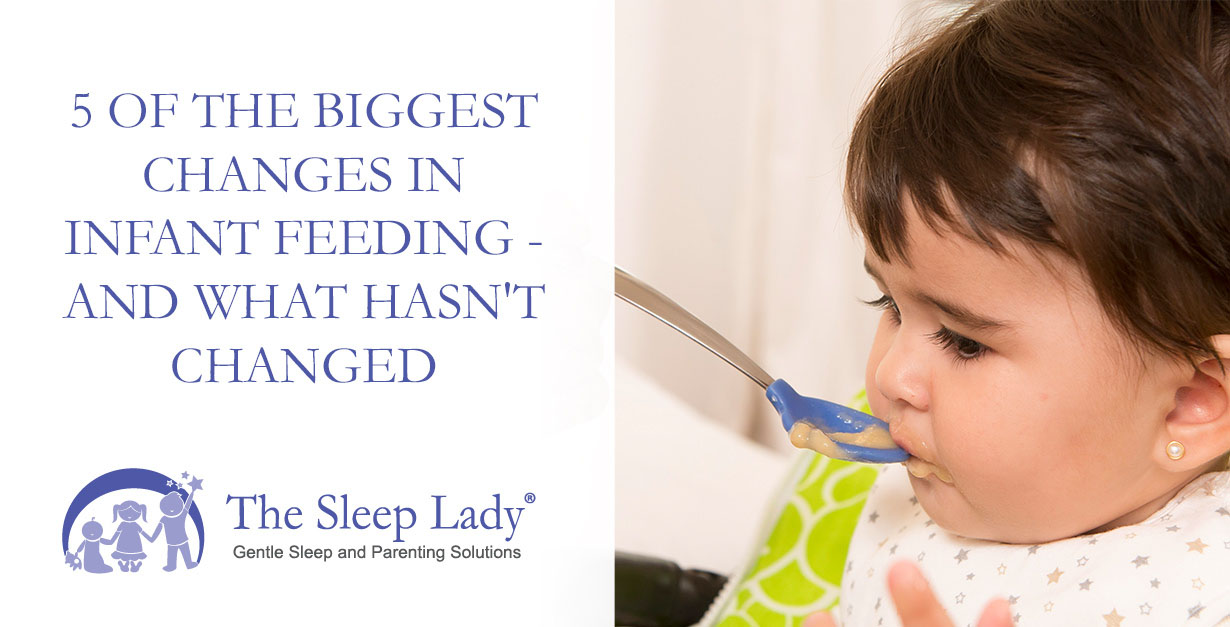I remember how clueless I felt when gearing up to feed my first baby. I was given all sorts of advice that made my head want to explode. Because I loved my baby so much, I wanted to give her the best.
As a dietitian, I decided to dig into the research and have kept up with it ever since (my baby was born 10 years ago!). Since that time, there have been big shifts in the recommendations for starting solids. Here, you get the latest and greatest information so you can feed your baby with confidence.
Don’t Delay Highly Allergenic Foods
Back in 2000, the American Academy of Pediatrics (AAP) recommended delayed introduction of highly allergenic foods for infants at high risk for food allergy. No cow’s milk for a year, no eggs until the child turned two, and no peanuts, tree nuts and fish until 3. But in 2008, the AAP backtracked a bit, highlighting the lack of evidence. As new evidence mounted that delayed introduction of allergenic foods (4-6 months) may do the opposite, the recommendations changed once again.
According to the American Academy of Allergy, Asthma and Immunology, there is no need to delay highly allergenic foods—cow’s milk protein, wheat, egg, soy, peanut, tree nuts, fish and shell fish—beyond 4-6 months of age. In fact, early introduction of safe forms of these foods may prevent food allergies.
When introducing these foods, be sure they aren’t the first food a baby eats and do it at home. Then wait a few days to see if there is a reaction. If your child is at risk for food allergies, visit an allergist for help.
Peanut allergy, one of the most problematic, has special considerations. Babies at high risk (severe eczema and/or egg allergy) should be tested between 4-6 months, where a doctor can decide about introduction. Those at moderate risk—mild to moderate eczema—can introduce a safe form of peanuts around 6 months. And those at low risk can introduce peanuts “freely.”
A safe form means nuts not in whole form, but a small amount added to other foods. Chunks of peanut butter are also a choking risk.
No Regular Sweet Offerings the First Two Years – and No Juice the First Year
The first two years is a rapid growth phase and a critical time for good nutrition. The American Academy recommends a nutrient rich diet without added sugar and salt. The American Heart Association recommends children under two don’t get regular sweets as part of their diet. And this year the AAP changed its juice guidelines, recommending no juice the first year.
Babies don’t need soda, juice or dessert throughout the week. Rather, let them try it occasionally but focus on a nutrient-rich diet to fill those little tummies.
Important Nutrients for Babies
You may notice that formula has changed quite a bit. With knowledge of nutrients needs the first two years—like DHA for brain development— things have changed. This is also why 200mg of daily DHA is recommended for breastfeeding moms, to be sure there is enough DHA in breast milk.
Vitamin D is also a nutrient of concern, which is why the AAP recommends breastfed babies be supplemented with 400IU vitamin D the first few days of life. Iron is another key nutrient during this rapid growth phaseAfter all, needs jump from <1mg at birth to 11mg at 6 months.
Forget Bland Baby Food
Gone are the days of bland baby food. Infancy is a time children are open to different tastes and textures. So go ahead and add spices, and don’t be afraid to expose baby to tastes the whole family enjoys. Research shows that babies introduced to a variety of foods early are more likely to be adventurous later.
Babies are also learning how to eat, so if you are traditional puree feeding, up the texture to challenge baby. The goal is for all babies to be feeding themselves by one year.
Be a Responsive Feeder
Some parents are skipping purees and opting for baby led weaning, which allows baby to feed himself from six months on. Some people like it because baby is less likely to be overfed than with spoon feeding.
But it’s important to partake in something health professionals call “responsive feeding,” whether you use the spoon or not. That means watching and honoring signs of hunger and fullness—and avoid feeding baby on the run, in the car, or the first sign of crying.
The goal is to lay the foundation for a healthy feeding relationship with your baby by making eye contact, feeding directly, and encouraging eating without forcing. Make mealtime a fun and enjoyable experience, and eat together as a family as soon as you can.
What Hasn’t Changed
While a lot has changed, some things have not. No honey or corn syrup is recommended the first year because they may contain botulism spores. And please avoid whole milk as a main source of nutrition—and milk alternatives like soy, rice and almond milk—until baby is a year. It should be breast milk or formula only.
Avoid foods that increase the risk of choking including hot dogs, nuts and seeds, chunks of meat or cheese, whole grapes, popcorn, chunks of peanut butter, raw vegetables, fruit chunks, chewing gum, or hard candy. Choking is the leading cause of death for children under three. Always supervise baby during meals!
Well there you have it. Key changes in the world of infant feeding. It will likely change again, but that’s science for you.





